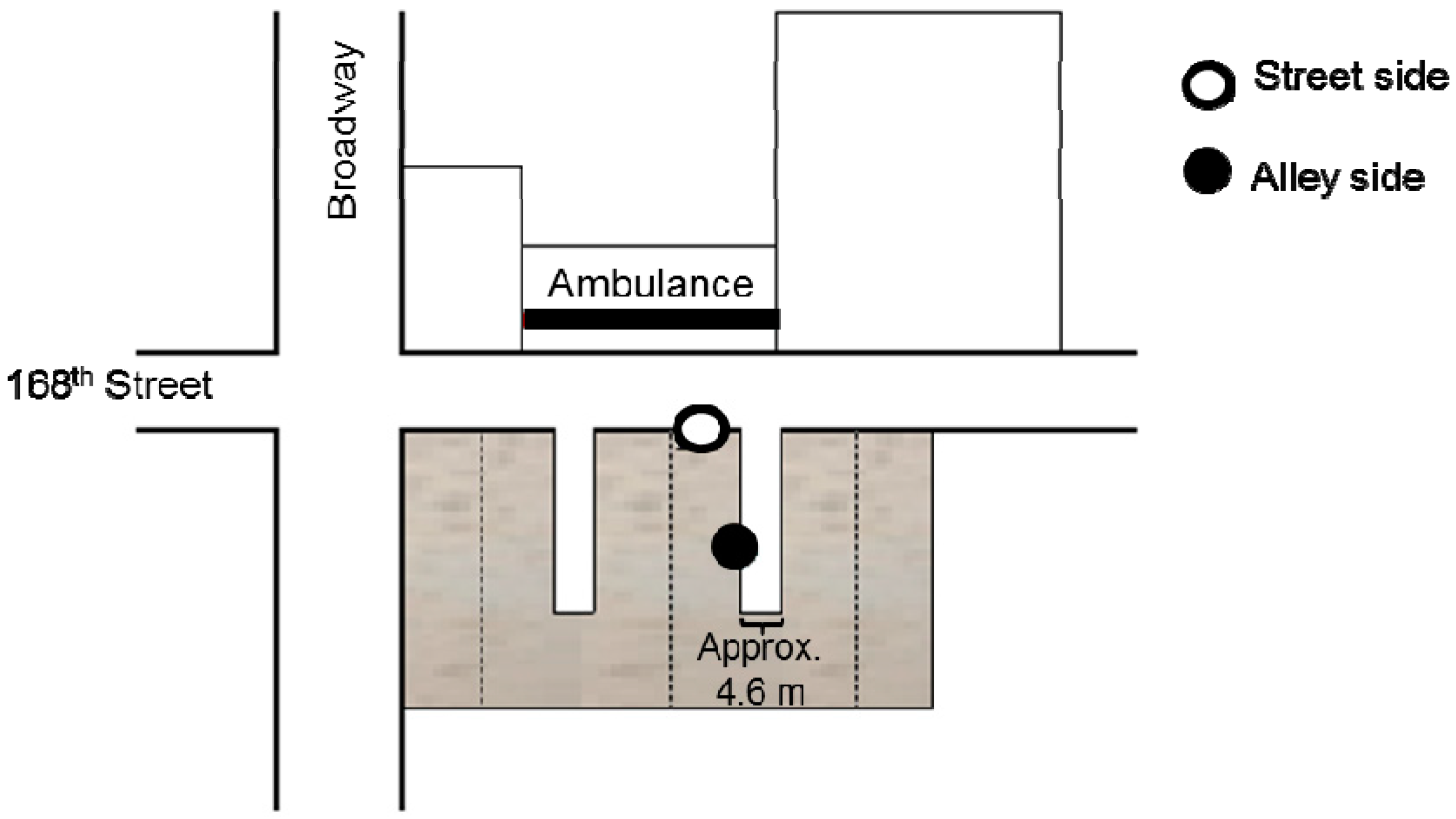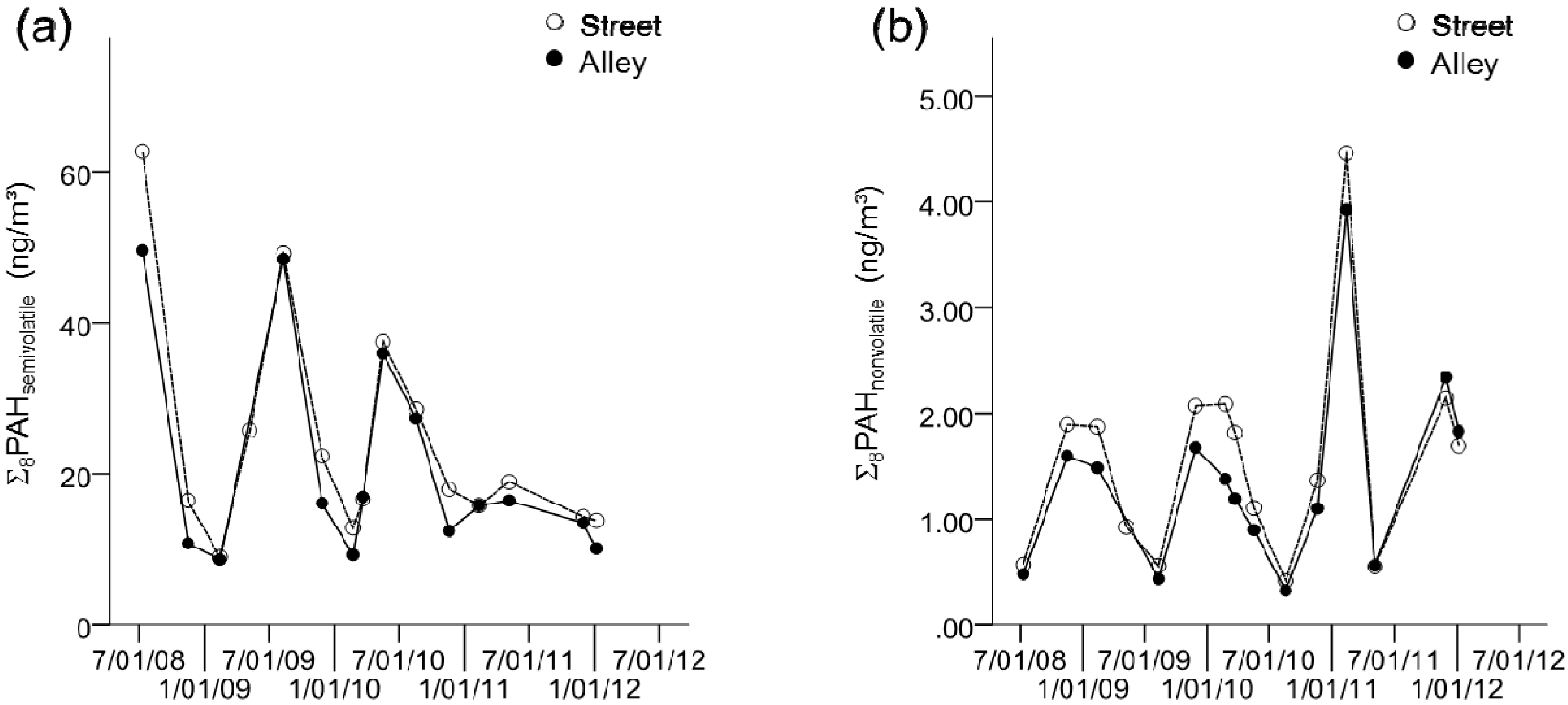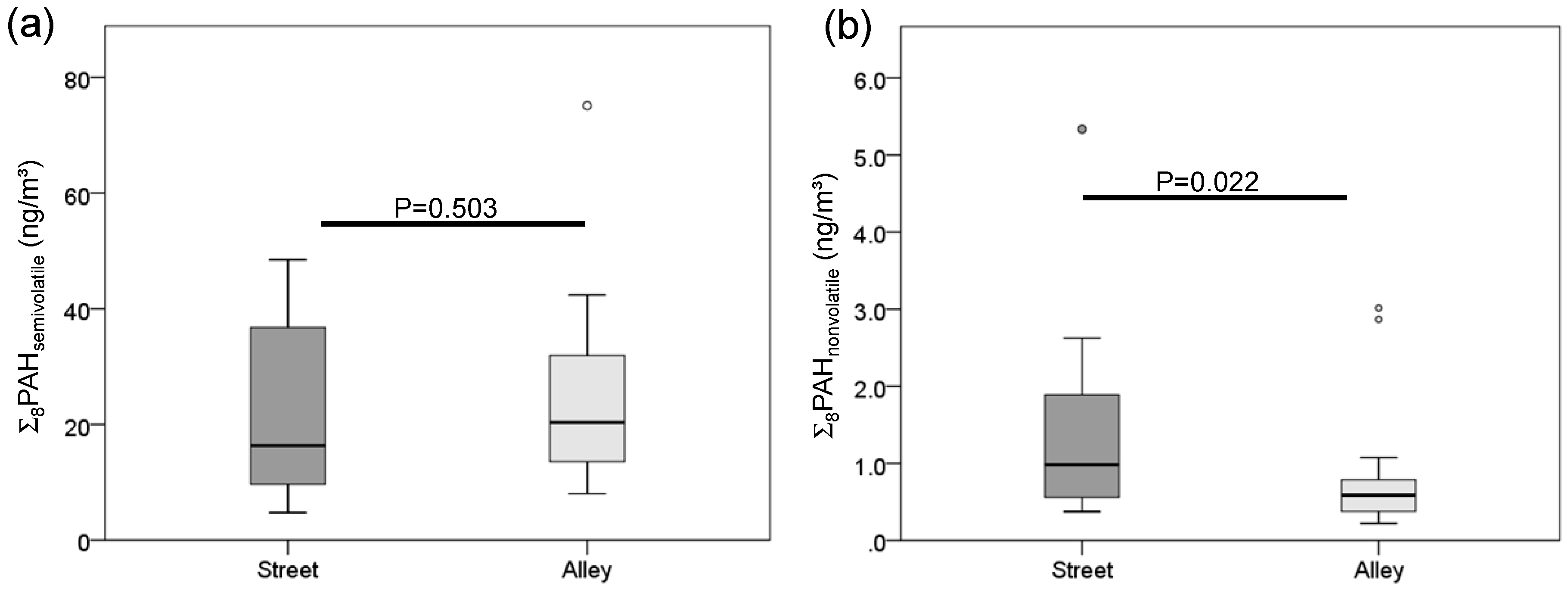Differences in Ambient Polycyclic Aromatic Hydrocarbon Concentrations between Streets and Alleys in New York City: Open Space vs. Semi-Closed Space
Abstract
:1. Introduction
2. Materials and Methods
2.1. Central Site Outdoor Air Monitoring

2.2. Residential Outdoor Air Monitoring
| Location of Monitor Placement | Number of Measurements | Building Floor Height | Number of Lanes on Street of Address |
|---|---|---|---|
| Central Site Street | 14 | 5 | 2 |
| Central Site Alley | 14 | 5 | 2 |
| Neighborhood Streets | 17 | 4 (2–26) a | 2 (1–4) a |
| Neighborhood Alleys | 18 | 4 (1–15) a | 2 (1–4) a |
2.3. Polycyclic Aromatic Hydrocarbon
2.4. Data Analysis
3. Results
3.1. Central Site Street vs. Alley PAH Concentrations
| Compounds | Street | Alley | Relative Difference a (%) | Wilcoxon p-Value b | Correlation Coefficient c |
|---|---|---|---|---|---|
| Σ8PAHsemivolatile | 20.59 (24.00 ± 15.49) | 17.46 (20.81 ± 14.04) | 16 | 0.002 | 0.93 *** |
| Pyrene | 0.89 (0.94 ± 0.34) | 0.83 (0.89 ± 0.33) | 7 | 0.198 | 0.90 *** |
| Phe | 15.50 (18.32 ± 12.35) | 12.63 (15.40 ± 10.98) | 21 | 0.001 | 0.94 *** |
| 1-MEPH | 0.58 (0.68 ± 0.41) | 0.55 (0.64 ± 0.41) | 5 | 0.109 | 0.94 *** |
| 2-MEPH | 1.14 (1.32 ± 0.80) | 1.07 (1.24 ± 0.78) | 6 | 0.064 | 0.90 *** |
| 3-MEPH | 1.27 (1.47 ± 0.93) | 1.18 (1.39 ± 0.90) | 7 | 0.084 | 0.94 *** |
| 9-MEPH | 0.81 (0.94 ± 0.59) | 0.78 (0.93 ± 0.62) | 4 | 0.363 | 0.96 *** |
| 1,7-DMEPH | 0.10 (0.13 ± 0.09) | 0.10 (0.12 ± 0.09) | 0 | 0.975 | 0.81 *** |
| 3,6-DMEPH | 0.18 (0.21 ± 0.11) | 0.18 (0.20 ± 0.11) | 0 | 0.470 | 0.82 *** |
| Σ8PAHnonvolatile | 1.32 (1.61 ± 1.04) | 1.10 (1.37 ± 0.94) | 18 | 0.011 | 0.90 *** |
| BaA | 0.08 (0.10 ± 0.07) | 0.08 (0.10 ± 0.07) | 0 | 0.363 | 0.89 *** |
| Chry | 0.16 (0.19 ± 0.11) | 0.15 (0.18 ± 0.11) | 6 | 0.683 | 0.93 *** |
| BbFA | 0.31 (0.40 ± 0.26) | 0.24 (0.31 ± 0.21) | 25 | 0.002 | 0.83 *** |
| BkFA | 0.07 (0.10 ± 0.07) | 0.06 (0.08 ± 0.05) | 15 | 0.064 | 0.90 *** |
| BaP | 0.07 (0.09 ± 0.08) | 0.07 (0.10 ± 0.09) | 0 | 0.470 | 0.93 *** |
| BghiP | 0.40 (0.48 ± 0.32) | 0.29 (0.37 ± 0.27) | 32 | 0.004 | 0.91 *** |
| IP | 0.19 (0.23 ± 0.16) | 0.18 (0.22 ± 0.15) | 5 | 0.056 | 0.97 *** |
| Daha | 0.03 (0.03 ± 0.02) | 0.02 (0.02 ± 0.01) | 40 | 0.019 | 0.61 *** |

3.2. Neighborhood-Wide Alley vs. Street PAH Concentrations
| Compounds | Overall | Heating Season b | Nonheating Season b | |||||||
|---|---|---|---|---|---|---|---|---|---|---|
| Street (n = 17) | Alley (n = 18) | Relative Difference a (%) | p | Street (n = 11) | Alley (n = 7) | Relative Difference a (%) | Street (n = 6) | Alley (n = 11) | Relative Difference a (%) | |
| Σ8PAHsemivolatile | 17.4 | 21.3 | −20 | 0.503 | 12.3 | 12.0 | 2 | 32.6 | 30.7 | 6 |
| Pyrene | 0.92 | 0.82 | 11 | 0.258 | 0.80 | 0.62 | 25 | 1.16 | 0.97 | 18 |
| Phe | 12.0 | 15.5 | −25 | 0.424 | 8.26 | 8.47 | −3 | 23.9 | 22.9 | 5 |
| 1-MEPH | 0.58 | 0.67 | −14 | 0.568 | 0.41 | 0.39 | 5 | 1.09 | 0.95 | 14 |
| 2-MEPH | 1.13 | 1.34 | −17 | 0.568 | 0.83 | 0.82 | 1 | 2.01 | 1.83 | 9 |
| 3-MEPH | 1.22 | 1.41 | −14 | 0.590 | 0.88 | 0.86 | 2 | 2.22 | 1.94 | 13 |
| 9-MEPH | 0.92 | 0.97 | −5 | 0.708 | 0.69 | 0.58 | 17 | 1.57 | 1.34 | 16 |
| 1,7-DMEPH | 0.10 | 0.11 | 10 | 0.405 | 0.07 | 0.05 | 33 | 0.19 | 0.19 | 0 |
| 3,6-DMEPH | 0.22 | 0.23 | −4 | 0.757 | 0.17 | 0.13 | 27 | 0.38 | 0.33 | 14 |
| Σ8PAHnonvolatile | 1.10 | 0.61 | 57 | 0.022 | 1.66 | 1.15 | 36 | 0.52 | 0.41 | 24 |
| BaA | 0.08 | 0.05 | 46 | 0.038 | 0.11 | 0.08 | 32 | 0.04 | 0.04 | 0 |
| Chry | 0.12 | 0.07 | 53 | 0.025 | 0.18 | 0.12 | 40 | 0.06 | 0.06 | 0 |
| BbFA | 0.24 | 0.12 | 67 | 0.019 | 0.39 | 0.24 | 48 | 0.10 | 0.07 | 35 |
| BkFA | 0.05 | 0.03 | 50 | 0.041 | 0.10 | 0.05 | 67 | 0.02 | 0.02 | 0 |
| BaP | 0.07 | 0.04 | 55 | 0.077 | 0.11 | 0.08 | 32 | 0.03 | 0.03 | 0 |
| BghiP | 0.33 | 0.18 | 59 | 0.032 | 0.48 | 0.37 | 26 | 0.16 | 0.11 | 37 |
| IP | 0.17 | 0.09 | 62 | 0.029 | 0.25 | 0.18 | 33 | 0.08 | 0.06 | 29 |
| Daha | 0.02 | 0.02 | 0 | 0.858 | 0.02 | 0.02 | 0 | 0.02 | 0.02 | 0 |

4. Discussion
5. Conclusions
Acknowledgments
Author Contributions
Conflicts of Interest
Abbreviations
| AM: Arithmetic Mean |
| CCCEH: Columbia Center for Children’s Environmental Health |
| GM: Geometric Mean |
| NYC: New York City |
| LOD: Limit of Detection |
| PAH: Polycyclic Aromatic Hydrocarbons |
| Σ8PAHsemivolatile: Sum of 8 low molecular-weight-PAH ≤ 206, including pyrene (Pye), phenanthrene (Phe), 1-methylphenanthrene (1Meph), 2-methylphenanthrene (2Meph), 3-methylphenanthrene (3Meph), 9-methylphenanthrene (9Meph), 1,7-dimethylphenanthrene (1,7DMeph), and 3,6-dimethylphenanthrene (3,6DMeph) |
| Σ8PAHnonvolatile: Sum of 8 high molecular-weight-PAH ≥ 228, including benz [a]anthracene (BaA), chrysene/iso-chrysene (Chry), benzo[b]fluoranthene (BbFA), benzo[k]fluoranthene (BkFA), benzo[a]pyrene (BaP), indeno[1,2,3-c,d]pyrene (IP), dibenz [a,h]anthracene (DahA), and benzo[g,h,i]perylene (BghiP). |
| PUF: Polyurethane Foam |
| SD: Standard Deviation |
References
- Brunekreef, B.; Holgate, S.T. Air pollution and health. Lancet 2002, 360, 1233–1242. [Google Scholar] [CrossRef]
- Miller, R.L.; Garfinkel, R.; Horton, M.; Camann, D.; Perera, F.; Whyatt, R.M.; Kinney, P.L. Polycyclic aromatic hydrocarbons, environmental tobacco smoke, and respiratory symptoms in an inner-city birth cohort. Chest 2004, 126, 1071–1078. [Google Scholar] [CrossRef] [PubMed]
- Perzanowski, M.S.; Chew, G.L.; Divjan, A.; Jung, K.H.; Ridder, R.; Tang, D.; Diaz, D.; Goldstein, I.F.; Kinney, P.L.; Rundle, A.G.; et al. Early-life cockroach allergen and polycyclic aromatic hydrocarbon exposures predict cockroach sensitization among inner-city children. J. Allergy Clin. Immunol. 2013, 131, 886–893. [Google Scholar] [PubMed]
- Jung, K.H.; Yan, B.; Moors, K.; Chillrud, S.N.; Perzanowski, M.S.; Whyatt, R.M.; Hoepner, L.; Goldstein, I.; Zhang, B.; Camann, D. Repeated exposure to polycyclic aromatic hydrocarbons and asthma: Effect of seroatopy. Ann. Allergy Asthma Immunol. 2012, 109, 249–254. [Google Scholar] [CrossRef] [PubMed]
- Lewtas, J. Air pollution combustion emissions: Characterization of causative agents and mechanisms associated with cancer, reproductive, and cardiovascular effects. Mutat. Res. 2007, 636, 95–133. [Google Scholar] [CrossRef] [PubMed]
- Bostrom, C.E.; Gerde, P.; Hanberg, A.; Jernstrom, B.; Johansson, C.; Kyrklund, T.; Rannug, A.; Tornqvist, M.; Victorin, K.; Westerholm, R. Cancer risk assessment, indicators, and guidelines for polycyclic aromatic hydrocarbons in the ambient air. Environ. Health Perspect. 2002, 110, 451–488. [Google Scholar] [CrossRef] [PubMed]
- Deziel, N.C.; Rull, R.P.; Colt, J.S.; Reynolds, P.; Whitehead, T.P.; Gunier, R.B.; Month, S.R.; Taggart, D.R.; Buffler, P.; Ward, M.H.; et al. Polycyclic aromatic hydrocarbons in residential dust and risk of childhood acute lymphoblastic leukemia. Environ. Res. 2014, 133, 388–395. [Google Scholar] [PubMed]
- Bjorseth, A.; Ramdahl, T. Handbook of Polycyclic Aromatic Hydrocarbons: Emission Sources and Recent Progress in Analytical Chemistry; Marcel Dekker: New York, NY, USA, 1985. [Google Scholar]
- Yan, B.; Bopp, R.F.; Abrajano, T.A.; Chaky, D.; Chillrud, S.N. Source apportionment of polycyclic aromatic hydrocarbons (pahs) into central park lake, new york city, over a century of deposition. Environ. Toxicol. Chem. 2014, 33, 985–992. [Google Scholar] [CrossRef] [PubMed]
- Choi, J.-H.; Xu, Q.-S.; Park, S.-Y.; Kim, J.-H.; Hwang, S.-S.; Lee, K.-H.; Lee, H.-J.; Hong, Y.-C. Seasonal variation of effect of air pollution on blood pressure. J. Epidemiol. Community Health 2007, 61, 314–318. [Google Scholar] [CrossRef] [PubMed]
- Lee, W.; Wang, Y.; Lin, T.; Chen, Y.; Lin, W.; Ku, C.; Cheng, J. Pah characteristics in the ambient air of traffic-source. Sci. Total Environ. 1995, 159, 185–200. [Google Scholar] [CrossRef]
- Jaward, F.M.; Barber, J.L.; Booij, K.; Jones, K.C. Spatial distribution of atmospheric PAHs and PCNs along a north–south atlantic transect. Environ. Pollut. 2004, 132, 173–181. [Google Scholar] [CrossRef] [PubMed]
- Nielsen, T. Traffic contribution of polycyclic aromatic hydrocarbons in the center of a large city. Atmos. Environ. 1996, 30, 3481–3490. [Google Scholar] [CrossRef]
- Levy, J.I.; Bennett, D.H.; Melly, S.J.; Spengler, J.D. Influence of traffic patterns on particulate matter and polycyclic aromatic hydrocarbon concentrations in Roxbury, Massachusetts. J. Expos. Anal. Environ. Epidem. 2003, 13, 364–371. [Google Scholar] [CrossRef] [PubMed]
- Choi, S.; Baek, S.; Chang, Y. Influence of a large steel complex on the spatial distribution of volatile polycyclic aromatic hydrocarbons (PAHs) determined by passive air sampling using membrane-enclosed copolymer (MECOP). Atmos. Environ. 2007, 41, 6255–6264. [Google Scholar] [CrossRef]
- Jung, K.H.; Artigas, F.; Shin, J.Y. Seasonal gradient patterns of polycyclic aromatic hydrocarbons and particulate matter concentrations near a highway. Atmosphere 2011, 2, 533–552. [Google Scholar] [CrossRef]
- Jung, K.H.; Bernabe, K.; Moors, K.; Yan, B.; Chillrud, S.N.; Whyatt, R.; Camann, D.; Kinney, P.L.; Perera, F.P.; Miller, R.L. Effects of floor level and building type on residential levels of outdoor and indoor polycyclic aromatic hydrocarbons, black carbon, and particulate matter in new york city. Atmosphere 2011, 2, 96–109. [Google Scholar] [CrossRef] [PubMed]
- Boehm, J.; Saba, T. Identification and allocation of polycyclic aromatic hydrocarbons. Exponent. Environ. Forens. Note 2008, 4, 1–4. [Google Scholar]
- Saha, M.; Togo, A.; Mizukawa, K.; Murakami, M.; Takada, H.; Zakaria, M.P.; Chiem, N.H.; Tuyen, B.C.; Prudente, M.; Boonyatumanond, R. Sources of sedimentary pahs in tropical asian waters: Differentiation between pyrogenic and petrogenic sources by alkyl homolog abundance. Mar. Pollut. Bull. 2009, 58, 189–200. [Google Scholar] [CrossRef] [PubMed]
- Ohura, T.; Amagai, T.; Fusaya, M.; Matsushita, H. Polycyclic aromatic hydrocarbons in indoor and outdoor environments and factors affecting their concentrations. Environ. Sci. Technol. 2004, 38, 77–83. [Google Scholar] [CrossRef] [PubMed]
- Jung, K.H.; Patel, M.M.; Moors, K.; Kinney, P.L.; Chillrud, S.N.; Whyatt, R.; Hoepner, L.; Garfinkel, R.; Yan, B. Effects of heating season on residential indoor and outdoor polycyclic aromatic hydrocarbons, black carbon, and particulate matter in an urban birth cohort. Atmos. Environ. 2010, 44, 4545–4552. [Google Scholar] [CrossRef] [PubMed]
- Ma, W.L.; Li, Y.F.; Qi, H.; Sun, D.Z.; Liu, L.Y.; Wang, D.G. Seasonal variations of sources of polycyclic aromatic hydrocarbons (PAHs) to a northeastern urban city, China. Chemosphere 2010, 79, 441–447. [Google Scholar] [CrossRef] [PubMed]
- Jung, K.H.; Liu, B.; Lovinsky-Desir, S.; Yan, B.; Camann, D.; Sjodin, A.; Li, Z.; Perera, F.; Kinney, P.; Chillrud, S.; et al. Time trends of polycyclic aromatic hydrocarbon exposure in New York city from 2001 to 2012: Assessed by repeat air and urine samples. Environ. Res. 2014, 131, 95–103. [Google Scholar] [PubMed]
- Rundle, A.; Hoepner, L.; Hassoun, A.; Oberfield, S.; Freyer, G.; Holmes, D.; Reyes, M.; Quinn, J.; Camann, D.; Perera, F. Association of childhood obesity with maternal exposure to ambient air polycyclic aromatic hydrocarbons during pregnancy. Am. J. Epidemiol. 2012, 175, 1163–1172. [Google Scholar] [CrossRef] [PubMed]
- Jane, C.; Chuang, G.A.M.; Miachel, R.K.; Nancy, K.W. Polycyclic aromatic hydrocarbons and their derivatives in indoor and outdoor air in an eight-home study. Atmosphere 1991, 25, 369–380. [Google Scholar]
- Naumova, Y.Y.; Eisenreich, S.J.; Turpin, B.J.; Weisel, C.P.; Morandi, M.T.; Colome, S.D.; Totten, L.A.; Stock, T.H.; Winer, A.M.; Alimokhtari, S.; et al. Polycyclic aromatic hydrocarbons in the indoor and outdoor air of three cities in the U.S. Environ. Sci. Technol. 2002, 36, 2552–2559. [Google Scholar] [PubMed]
- Fromme, H.; Lahrz, T.; Piloty, M.; Gebhardt, H.; Oddoy, A.; Ruden, H. Polycyclic aromatic hydrocarbons inside and outside of apartments in an urban area. Sci. Total Environ. 2004, 326, 143–149. [Google Scholar] [CrossRef] [PubMed]
- Whyatt, R.M.; Garfinkel, R.; Hoepner, L.A.; Holmes, D.; Borjas, M.; Williams, M.K.; Reyes, A.; Rauh, V.; Perera, F.P.; Camann, D.E. Within-and between-home variability in indoor-air insecticide levels during pregnancy among an inner-city cohort from New York city. Environ. Health Perspect. 2007, 115, 383–389. [Google Scholar] [CrossRef] [PubMed]
- Tonne, C.; Whyatt, R.; Camann, D.; Perera, F.; Kinney, P. Predictors of personal polycyclic aromatic hydrocarbon exposures among pregnant minority women in New York city. Environ. Health Perspect. 2004, 112, 754–760. [Google Scholar] [CrossRef] [PubMed]
- Boffetta, P. Cancer risk from occupational and environmental exposure to polycylic aromatic hydrocarbons. Cancer Cause Control 1997, 8, 442–472. [Google Scholar] [CrossRef]
- Jung, K.H.; Yan, B.; Chillrud, S.N.; Perera, F.P.; Whyatt, R.; Camann, D.; Kinney, P.L.; Miller, R.L. Assessment of benzo (a) pyrene-equivalent carcinogenicity and mutagenicity of residential indoor vs. outdoor polycyclic aromatic hydrocarbons exposing young children in New York city. Int. J. Environ. Res. Public Health 2010, 7, 1889–1900. [Google Scholar] [PubMed]
- Clements, A.; Jia, Y.; Denbleyker, A.; McDonald-Buller, E.; Fraser, M.; Allen, D.; Collins, D.; Michel, E.; Pudota, J.; Sullivan, D.; et al. Air pollutant concentrations near three texas roadways, part ii: Chemical characterization and transformation of pollutants. Atmos. Environ. 2009, 43, 4523–4534. [Google Scholar]
- Schauer, C.; Niessner, R.; Pöschl, U. Polycyclic aromatic hydrocarbons in urban air particulate matter: Decadal and seasonal trends, chemical degradation, and sampling artifacts. Environ. Sci. Technol. 2003, 37, 2861–2868. [Google Scholar] [CrossRef] [PubMed]
- Zheng, M.; Salmon, L.G.; Schauer, J.J.; Zeng, L.; Kiang, C.S.; Zhang, Y.; Cass, G.R. Seasonal trends in PM2.5 source contributions in Beijing, China. Atmos. Environ. 2005, 39, 3967–3976. [Google Scholar] [CrossRef]
- Taseiko, O.V.; Mikhailuta, S.V.; Pitt, A.; Lezhenin, A.A.; Zakharov, Y.V. Air pollution dispersion within urban street canyons. Atmos. Environ. 2009, 43, 245–252. [Google Scholar] [CrossRef]
- Weber, S.; Kordowski, K.; Kuttler, W. Variability of particle number concentration and particle size dynamics in an urban street canyon under different meteorological conditions. Sci. Total Environ. 2013, 449, 102–114. [Google Scholar] [CrossRef] [PubMed]
- De Nicola, F.; Murena, F.; Costagliola, M.A.; Alfani, A.; Baldantoni, D.; Prati, M.V.; Sessa, L.; Spagnuolo, V.; Giordano, S. A multi-approach monitoring of particulate matter, metals and pahs in an urban street canyon. Environ. Sci. Pollut Res. 2013, 20, 4969–4979. [Google Scholar] [CrossRef] [PubMed]
- Ng, W.Y.; Chau, C.K. A modeling investigation of the impact of street and building configurations on personal air pollutant exposure in isolated deep urban canyons. Sci. Total Environ. 2014, 468, 429–448. [Google Scholar] [CrossRef] [PubMed]
© 2016 by the authors; licensee MDPI, Basel, Switzerland. This article is an open access article distributed under the terms and conditions of the Creative Commons by Attribution (CC-BY) license (http://creativecommons.org/licenses/by/4.0/).
Share and Cite
Lovinsky-Desir, S.; Miller, R.L.; Bautista, J.; Gil, E.N.; Chillrud, S.N.; Yan, B.; Camann, D.; Perera, F.P.; Jung, K.H. Differences in Ambient Polycyclic Aromatic Hydrocarbon Concentrations between Streets and Alleys in New York City: Open Space vs. Semi-Closed Space. Int. J. Environ. Res. Public Health 2016, 13, 127. https://doi.org/10.3390/ijerph13010127
Lovinsky-Desir S, Miller RL, Bautista J, Gil EN, Chillrud SN, Yan B, Camann D, Perera FP, Jung KH. Differences in Ambient Polycyclic Aromatic Hydrocarbon Concentrations between Streets and Alleys in New York City: Open Space vs. Semi-Closed Space. International Journal of Environmental Research and Public Health. 2016; 13(1):127. https://doi.org/10.3390/ijerph13010127
Chicago/Turabian StyleLovinsky-Desir, Stephanie, Rachel L. Miller, Joshua Bautista, Eric N. Gil, Steven N. Chillrud, Beizhan Yan, David Camann, Frederica P. Perera, and Kyung Hwa Jung. 2016. "Differences in Ambient Polycyclic Aromatic Hydrocarbon Concentrations between Streets and Alleys in New York City: Open Space vs. Semi-Closed Space" International Journal of Environmental Research and Public Health 13, no. 1: 127. https://doi.org/10.3390/ijerph13010127
APA StyleLovinsky-Desir, S., Miller, R. L., Bautista, J., Gil, E. N., Chillrud, S. N., Yan, B., Camann, D., Perera, F. P., & Jung, K. H. (2016). Differences in Ambient Polycyclic Aromatic Hydrocarbon Concentrations between Streets and Alleys in New York City: Open Space vs. Semi-Closed Space. International Journal of Environmental Research and Public Health, 13(1), 127. https://doi.org/10.3390/ijerph13010127





